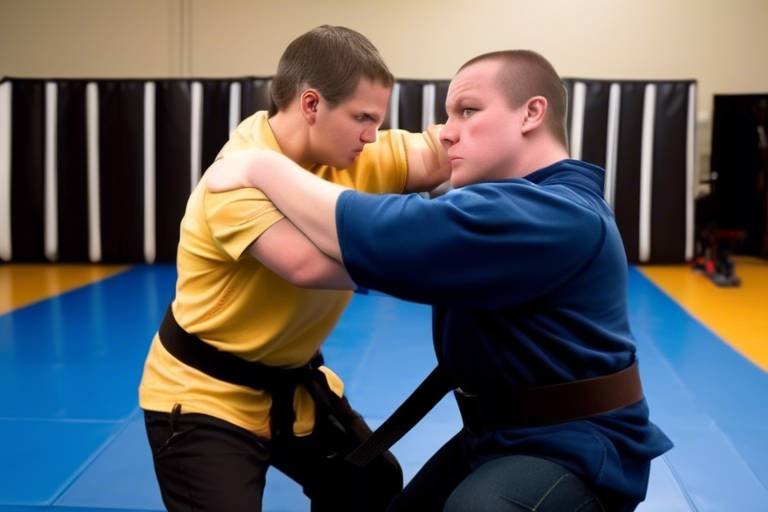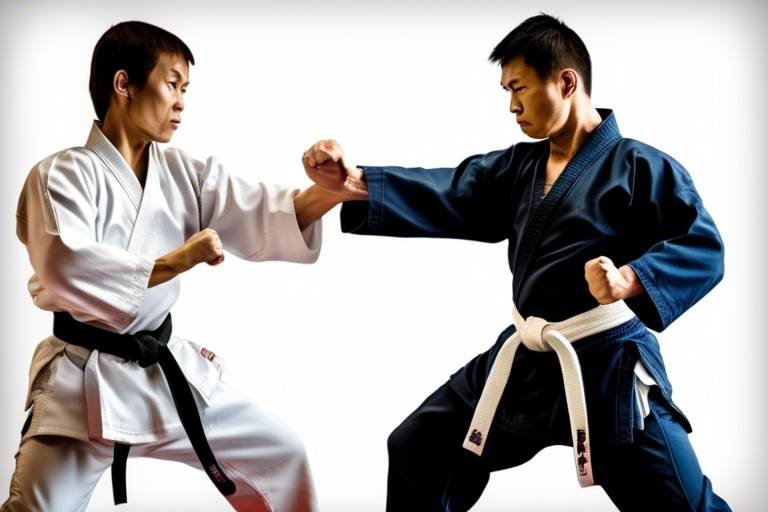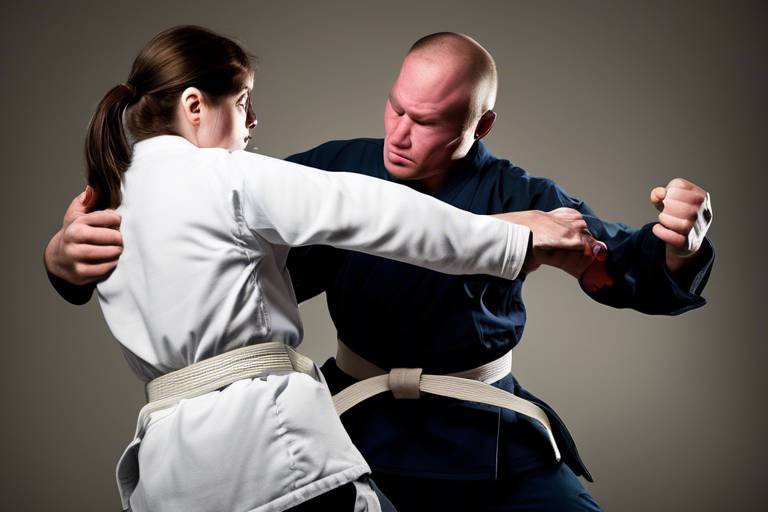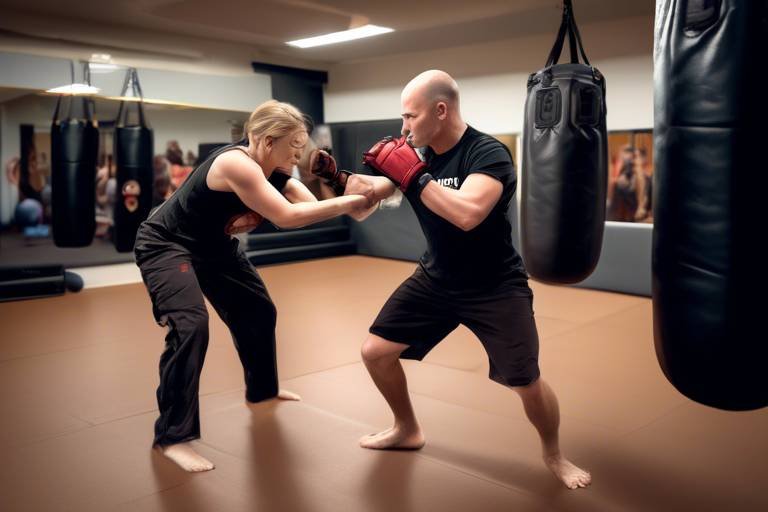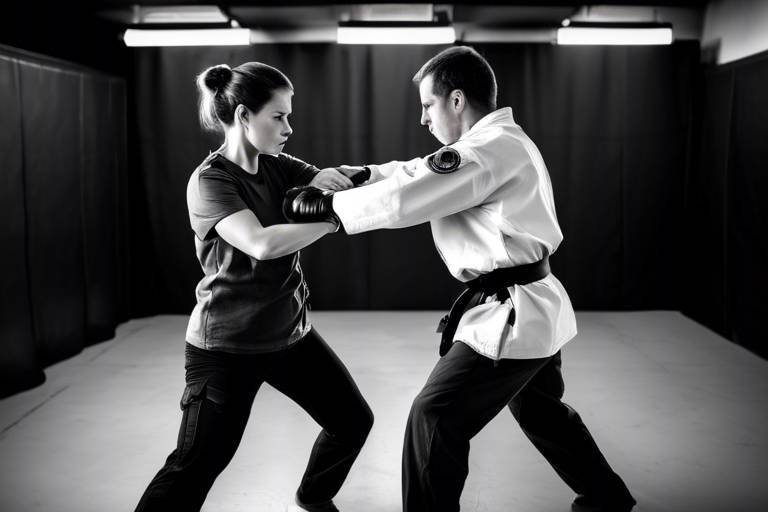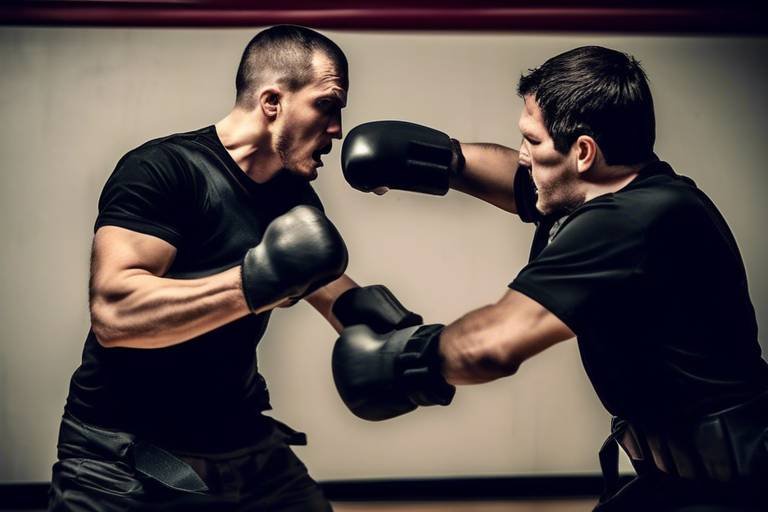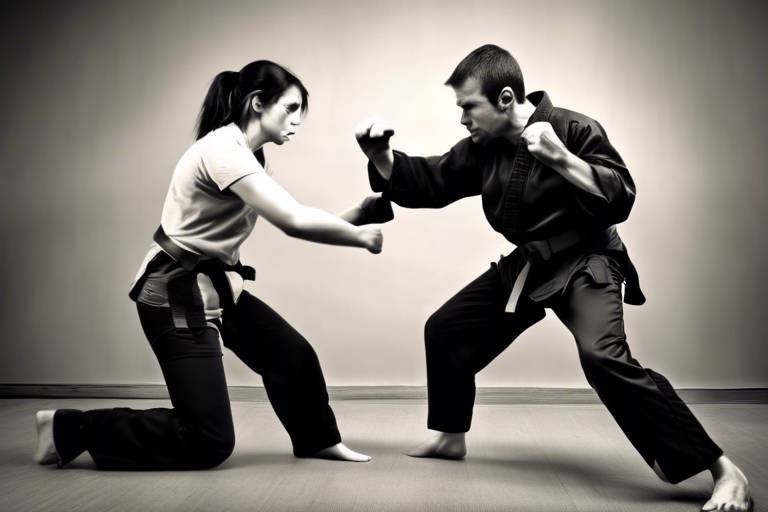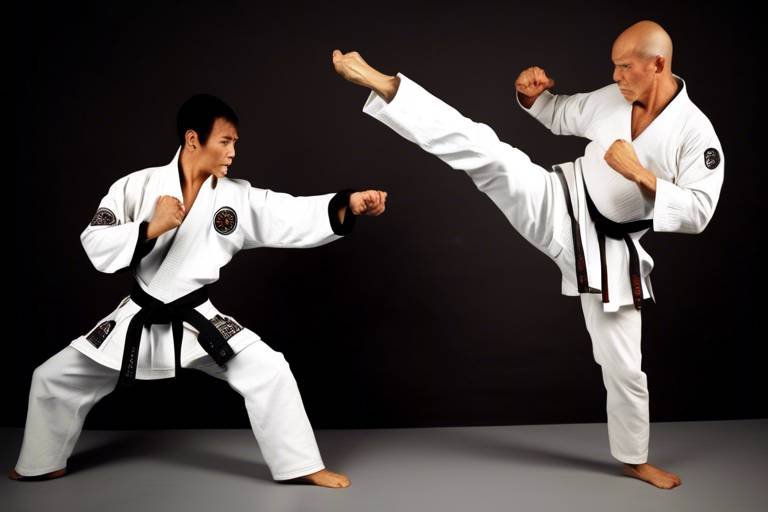Top Self-Defense Techniques for Individuals with Physical Disabilities
In today’s world, the importance of self-defense cannot be overstated, especially for individuals with physical disabilities. The ability to protect oneself is a fundamental right, and it’s crucial to highlight that everyone, regardless of their physical capabilities, can learn effective self-defense techniques. This article explores various self-defense strategies tailored specifically for individuals with disabilities, emphasizing empowerment, adaptability, and safety in potentially dangerous situations.
Self-defense is not just about physical strength; it’s about using your environment, your skills, and your wits to stay safe. Imagine being in a situation where you need to defend yourself. Wouldn't it be empowering to know that you have the tools and techniques at your disposal to handle it? This article will guide you through various methods, ensuring that you feel confident and prepared.
Understanding the diverse nature of physical disabilities is the first step in crafting effective self-defense strategies. Disabilities can range from mobility impairments to sensory challenges, each requiring a personalized approach. It’s essential to recognize that what works for one person may not work for another. Therefore, adapting techniques to fit individual needs is not just beneficial; it’s necessary. This adaptability is a crucial theme throughout this article, as we explore various techniques and tools that can enhance personal safety.
When discussing self-defense for individuals with physical disabilities, it’s important to acknowledge the various types of disabilities that exist. For instance, someone who uses a wheelchair may face different challenges than someone with limited arm mobility. By understanding these differences, we can tailor strategies that not only empower individuals but also respect their unique situations. The goal is to create a safe environment where everyone can learn and practice self-defense without feeling overwhelmed or intimidated.
Moreover, it’s essential to foster a mindset that values adaptability. Just as a chameleon changes its colors to blend into its environment, individuals with disabilities can learn to adapt self-defense techniques to suit their abilities. This adaptability is what transforms a potentially vulnerable situation into one where individuals feel empowered and in control.
Adapting self-defense techniques to meet individual needs is crucial. This means recognizing that traditional self-defense methods may not be suitable for everyone. For example, techniques that rely heavily on speed and agility may not be effective for someone with limited mobility. Instead, we can focus on techniques that emphasize leverage, awareness, and the use of tools or aids. This approach ensures that self-defense remains effective without compromising safety.
Mobility aids can be powerful tools in self-defense. Items such as canes, walkers, and wheelchairs can be used creatively to enhance personal safety. For instance, a cane can serve not only as a support tool but also as a striking or blocking implement in a self-defense situation. Similarly, individuals using wheelchairs can leverage their chair’s structure to create defensive barriers or to maneuver effectively away from threats.
When it comes to self-defense, canes can be incredibly versatile. They can be used to create distance between oneself and an aggressor or to deliver impactful strikes. Think of a cane as an extension of your arm; it can block incoming attacks or be used to jab at an assailant. With the right training, individuals can learn to wield their canes with confidence, turning a common mobility aid into a formidable self-defense tool.
For wheelchair users, self-defense strategies should focus on utilizing the wheelchair’s structure. Techniques may include using the wheelchair to create barriers, employing quick maneuvers to escape threats, and even using the wheels to push away an aggressor. The key is to think outside the box and recognize that the wheelchair itself can be an asset in a self-defense scenario.
Verbal self-defense is another crucial aspect that often gets overlooked. It’s not always about physical confrontation; sometimes, the best defense is to de-escalate the situation with words. Effective communication can often diffuse tension before it escalates into violence. Using assertive language and maintaining a confident posture can send a clear message that you are not an easy target. Remember, your voice can be as powerful as your fists!
Access to proper training and resources is vital for individuals with disabilities. Fortunately, many programs and classes are designed specifically to cater to their needs. Online resources have also become increasingly popular, offering flexibility for those who may have difficulty attending in-person classes. It’s essential to explore these options to find the best fit for your learning style and physical capabilities.
Selecting an instructor who understands the unique challenges faced by individuals with disabilities is critical. Look for trainers who have experience working with diverse populations and can adapt their teaching methods accordingly. A good instructor will not only teach you techniques but will also empower you to feel confident in your abilities.
Online self-defense training can offer flexibility and accessibility, making it easier for individuals with disabilities to learn at their own pace. Various platforms provide courses specifically tailored to meet the needs of those with physical challenges. These resources can be invaluable in building skills and confidence in a safe, comfortable environment.
- Can individuals with disabilities really learn self-defense? Yes! Self-defense techniques can be adapted to suit various physical abilities, empowering individuals to protect themselves.
- What types of self-defense classes are available for individuals with disabilities? Many classes are tailored specifically for individuals with disabilities, focusing on adaptive techniques and tools.
- Are mobility aids useful in self-defense? Absolutely! Mobility aids like canes and wheelchairs can be effectively used as defensive tools when trained properly.

Understanding Physical Disabilities in Self-Defense
When it comes to self-defense, understanding the unique challenges faced by individuals with physical disabilities is crucial. Physical disabilities can vary widely, ranging from mobility impairments to sensory disabilities, and each type influences the way one might approach self-defense. For instance, someone who uses a wheelchair may have different strategies compared to someone who has limited arm strength. The key here is to recognize that self-defense is not a one-size-fits-all solution; it requires a personalized approach that takes into account the individual's specific circumstances.
It's important to note that physical disabilities do not diminish a person's ability to defend themselves. In fact, many individuals with disabilities develop heightened awareness and adaptability, which can be powerful assets in self-defense situations. Understanding the various types of disabilities can help tailor self-defense techniques effectively. Below are some common categories of physical disabilities:
- Mobility Impairments: These include conditions that affect a person's ability to move freely, such as paralysis, arthritis, or amputations.
- Sensory Disabilities: This category encompasses visual and hearing impairments that might affect situational awareness.
- Cognitive Disabilities: These may influence decision-making or reaction times, impacting how an individual might respond in a crisis.
By understanding these categories, instructors and individuals can work together to create effective self-defense strategies that consider the unique strengths and limitations of each person. For example, someone with a mobility impairment might focus on techniques that leverage their environment, while a person with a sensory disability might prioritize situational awareness and effective communication.
Ultimately, the goal of self-defense training for individuals with physical disabilities is empowerment. It’s about equipping them with the skills and confidence to handle potentially dangerous situations. This not only enhances their safety but also fosters a sense of independence and self-reliance, which is invaluable in today’s world. By embracing a personalized approach to self-defense, we can ensure that everyone, regardless of their physical abilities, can feel secure and capable in their ability to protect themselves.

Adapting Techniques for Individual Needs
When it comes to self-defense, one size definitely does not fit all. Individuals with physical disabilities often face unique challenges that require a tailored approach to self-defense techniques. The essence of adapting these techniques lies in understanding that empowerment and adaptability are key. It's not just about learning how to throw a punch or execute a kick; it's about finding methods that resonate with each person's abilities and comfort levels.
For instance, someone with limited mobility might struggle with traditional martial arts techniques that require a lot of movement or agility. Instead, they can focus on techniques that prioritize leverage and positioning. This might include using their body weight to create distance from an aggressor or employing defensive maneuvers that minimize the need for extensive physical exertion. The goal is to transform what could be perceived as a limitation into a strategic advantage.
It’s also important to recognize that self-defense isn’t solely about physical confrontation. Verbal self-defense is a powerful tool that can de-escalate situations before they turn violent. This involves being assertive in your communication, setting boundaries, and using your voice to assert your presence. For many individuals with disabilities, these verbal techniques can be just as effective, if not more so, than physical techniques.
Another critical aspect of adapting self-defense techniques is the incorporation of mobility aids. These tools can be utilized creatively to enhance self-defense strategies. For example, a cane can serve as a striking tool or a means of creating distance. Similarly, individuals in wheelchairs can learn to use their chair's structure to their advantage, employing it as a barrier or a means of escape. The adaptability of techniques ensures that everyone can find a method that works for them.
To further illustrate the importance of personalized self-defense strategies, let’s look at some key adaptations:
| Technique | Adaptation for Disabilities |
|---|---|
| Striking | Focus on using mobility aids like canes for striking or blocking. |
| Distance Management | Utilize your body and surroundings to create space between you and an aggressor. |
| Escape Techniques | Learn to maneuver your wheelchair effectively to navigate away from danger. |
| Verbal Defense | Practice assertive communication to deter potential threats. |
Ultimately, adapting self-defense techniques for individual needs is about recognizing the unique strengths and challenges each person brings to the table. It’s about fostering a sense of confidence and independence in the face of adversity. By focusing on what works best for them, individuals with physical disabilities can not only enhance their safety but also empower themselves in ways they might not have thought possible.

Utilizing Mobility Aids
Mobility aids are often viewed solely as tools for assistance, but they can also serve as powerful defensive mechanisms in self-defense scenarios. Whether it’s a cane, wheelchair, or walker, these aids can be adapted to enhance personal safety and confidence. Imagine walking down the street, and suddenly feeling threatened; instead of feeling vulnerable, you can turn your mobility aid into a means of protection. This shift in perspective is not just empowering; it's essential for anyone looking to bolster their self-defense capabilities.
First, let's consider the cane. Many people think of canes merely as walking sticks, but they can be transformed into effective defensive tools. A cane can be used to jab at an attacker, block incoming strikes, or even trip an assailant. The key is in the technique. With some practice, you can learn to wield your cane with confidence, using it to create distance between yourself and a potential threat. In fact, the average cane can be surprisingly sturdy, allowing for a significant amount of force to be applied if necessary. Here’s a quick breakdown of how to use a cane effectively:
| Technique | Description |
|---|---|
| Jabbing | Use the tip of the cane to strike at an attacker's vulnerable areas, such as the stomach or face. |
| Blocking | Position the cane horizontally to deflect incoming strikes or projectiles. |
| Tripping | Extend the cane to trip an attacker, causing them to lose balance and fall. |
Now, let’s talk about wheelchair users. A wheelchair is not just a mode of transportation; it can be a vital asset in self-defense. The structure of a wheelchair allows for unique strategies that can leverage its design for both mobility and protection. For instance, you can use the wheels to maneuver away from an attacker quickly or position the chair as a barrier between yourself and a potential threat. Additionally, the armrests can be utilized to block strikes, and the footrests can serve as a means to push away an aggressor.
Moreover, the ability to move swiftly in a wheelchair can be an advantage. You can quickly change directions or escape from a dangerous situation, making it crucial to practice these maneuvers regularly. Understanding how to use your wheelchair effectively not only boosts your confidence but also enhances your overall safety. Remember, self-defense is about being aware of your surroundings and using what you have at your disposal to protect yourself.
Finally, it’s important to embrace the mindset that using mobility aids in self-defense is about adaptability. Every individual has unique challenges, and the goal is to find techniques that work best for you. Practice makes perfect, so consider seeking out self-defense classes that focus on utilizing mobility aids. By doing so, you will not only learn valuable techniques but also gain a sense of empowerment that comes from knowing you can protect yourself, no matter your circumstances.

Canes as Defensive Tools
When we think of self-defense, the first image that often pops into our minds is that of martial arts experts executing complex moves. However, for individuals with physical disabilities, the tools available for self-defense can be both practical and effective. One such tool is the cane. While traditionally viewed as a mobility aid, a cane can also serve as a powerful defensive weapon, providing both protection and a sense of empowerment.
Imagine walking down a dimly lit street, feeling a little uneasy. The presence of a cane not only aids your mobility but also offers you a means of defense. The key is understanding how to use it effectively. A cane can be utilized in various ways, such as:
- Striking: A quick jab or swing can create distance between you and an aggressor.
- Blocking: The cane can serve as a barrier against incoming strikes, allowing you to protect yourself.
- Distraction: A swift movement with the cane can distract an attacker long enough for you to escape.
To maximize the effectiveness of a cane in self-defense, it's crucial to understand its anatomy. Most canes are designed with a sturdy shaft and a comfortable grip, which can be leveraged in various defensive maneuvers. For instance, the cane's tip can be used to poke or jab, while the shaft can be swung to create a wide arc of protection. It’s all about using what you have at your disposal to your advantage.
Additionally, practicing specific techniques with your cane can make all the difference. Here are some basic moves to consider:
| Technique | Description |
|---|---|
| Jab | Quickly thrusting the cane forward to create distance. |
| Swipe | A horizontal swing that can knock away an attacker’s hands or objects. |
| Block | Using the cane to deflect incoming strikes. |
Moreover, self-defense is not just about physical confrontation; it's also about being aware of your surroundings. A cane can help you maintain your balance and posture, allowing you to stay alert and ready to react to any potential threats. Just like a knight with a sword, wielding your cane with confidence can deter potential attackers, as they may think twice before approaching someone who appears prepared to defend themselves.
In conclusion, canes are not just for support; they can be transformed into effective defensive tools. By incorporating them into your self-defense strategy, you can enhance your safety and confidence in various situations. Remember, the goal is to empower yourself and utilize your resources wisely. With practice and the right mindset, your cane can become an extension of yourself, ready to protect you when needed.

Wheelchair Defense Strategies
When it comes to self-defense for wheelchair users, the key lies in leveraging the unique advantages that come with the wheelchair itself. Think of your wheelchair as more than just a mobility aid; it can be a powerful tool for protection and a means to create space between you and a potential attacker. The first step in developing effective defense strategies is understanding how to utilize your wheelchair's structure to your advantage. For instance, the wheels can be used to maneuver quickly, allowing you to evade an attacker while maintaining your balance and stability.
One effective strategy is to position your wheelchair in a way that creates a barrier between you and the aggressor. By angling your chair, you can make it more difficult for someone to approach you directly. This positioning not only provides you with a defensive stance but also gives you a clear view of your surroundings, allowing you to spot potential threats before they escalate. Additionally, using your arms to push against the wheels can help you shift your weight, enabling you to pivot quickly if needed.
Another essential aspect of wheelchair defense is the use of your arms and hands. They can act as striking tools or shields. For example, you can use a quick jab with your arm to distract or push away an attacker while simultaneously using your wheelchair to back away from the situation. This technique requires practice, but it can be incredibly effective in creating the distance necessary to escape. Moreover, if you have upper body strength, consider practicing strikes that can be delivered from your seated position, such as punches or slaps aimed at vulnerable areas like the face or throat.
Furthermore, incorporating mobility aids such as a personal alarm or a pepper spray canister within easy reach can enhance your defense strategy. These tools can provide a critical layer of protection, allowing you to alert others or deter threats without needing to engage physically. Remember, the goal is not to engage in a fight but to create an opportunity to escape safely.
Lastly, practice is vital. Engaging in self-defense training specifically designed for wheelchair users can help you develop the confidence and skills needed to respond effectively in a crisis. Consider working with an instructor who understands the unique challenges faced by wheelchair users and can tailor training to your specific needs. Regular practice will not only improve your skills but also boost your confidence, making you feel more empowered in any situation.
- Can wheelchair users effectively defend themselves?
Absolutely! With the right techniques and adaptations, wheelchair users can employ various self-defense strategies that utilize their mobility aids to their advantage. - What should I look for in a self-defense instructor?
Look for an instructor who has experience working with individuals with disabilities and understands the unique challenges you may face. - Are there online resources for wheelchair self-defense training?
Yes, many platforms offer online courses specifically designed for individuals with physical disabilities, providing flexible training options.

Verbal Self-Defense Techniques
When we think about self-defense, our minds often jump to physical techniques—strikes, blocks, and grappling moves. However, verbal self-defense is an equally important skill that can help individuals, especially those with physical disabilities, navigate potentially dangerous situations. Imagine being able to diffuse a tense encounter simply by using your words; that’s the power of effective communication!
Verbal self-defense is all about using your voice and body language to assert yourself, establish boundaries, and de-escalate conflict. It’s like having a shield made of words instead of fists. This technique is not just about what you say, but how you say it. Your tone, volume, and body posture play a crucial role in conveying confidence and authority. For instance, a firm tone can communicate strength, while a shaky voice might signal uncertainty.
Here are some key strategies to enhance your verbal self-defense skills:
- Stay Calm: Keeping your composure is vital. A calm demeanor can often disarm an aggressive individual.
- Use Clear Language: Be direct and assertive. Phrases like “Please stop” or “I don’t want any trouble” can be effective.
- Establish Boundaries: Clearly state your limits. For example, “I’m not comfortable with you getting this close” can help maintain personal space.
- Practice Active Listening: Sometimes, simply listening can help de-escalate a situation. It shows the other person that you are engaged and willing to communicate.
Additionally, using “I” statements can be very powerful. Instead of saying, “You’re being rude,” try framing it as “I feel uncomfortable when you speak to me that way.” This approach shifts the focus from blaming to expressing your feelings, which can lead to a more productive conversation.
Another crucial aspect of verbal self-defense is recognizing when to walk away. Not every situation can or should be resolved verbally. If you sense that the conversation is escalating or the other person is unwilling to listen, it’s perfectly acceptable to remove yourself from the situation. Remember, your safety is the priority!
Incorporating these verbal self-defense techniques into your arsenal not only empowers you but also enhances your confidence in handling various situations. It’s about turning potential threats into opportunities for resolution through communication. Just as a skilled negotiator can diffuse a tense situation, so too can you become adept at using your voice as a powerful tool for self-defense.

Training and Resources
Access to proper training and resources is vital for individuals with disabilities seeking to enhance their self-defense skills. The journey to empowerment through self-defense is not just about learning techniques; it's also about finding the right support systems that cater to individual needs. Imagine walking into a self-defense class and feeling completely understood and supported—this is what tailored training can offer. There are numerous programs available that focus specifically on adapting self-defense strategies for people with physical disabilities. These programs often emphasize not only physical techniques but also mental preparedness and confidence-building, which are crucial in any self-defense scenario.
Many organizations and instructors recognize the unique challenges faced by individuals with disabilities and have developed specialized courses. These classes often incorporate adaptive techniques that allow participants to learn at their own pace and comfort level. For instance, some classes may focus on using mobility aids effectively, while others might emphasize verbal de-escalation techniques. The key is to find a program that aligns with personal capabilities and comfort zones, ensuring a safe and supportive learning environment.
In addition to in-person training, there are also a plethora of online resources available. Online self-defense courses can provide flexibility and accessibility, allowing individuals to learn from the comfort of their own homes. These courses often include video demonstrations, interactive scenarios, and comprehensive guides tailored to various disabilities. Platforms like Udemy, Skillshare, and even specialized websites dedicated to self-defense education offer courses that can be accessed at any time, making it easier to fit training into a busy schedule.
Furthermore, when looking for the right instructor, it's essential to consider their experience and understanding of disabilities. A qualified instructor should not only be skilled in self-defense techniques but also possess the sensitivity to adapt these techniques for individuals with varying abilities. Here are some tips for finding the right instructor:
- Look for instructors who have specific training in adaptive self-defense.
- Seek out reviews or testimonials from other individuals with disabilities who have taken their classes.
- Ask about their approach to teaching and how they plan to accommodate individual needs.
Ultimately, the goal is to foster a sense of safety and empowerment. The right training and resources can make a world of difference in one's ability to defend themselves. By investing time in finding the right programs and instructors, individuals with disabilities can gain the confidence and skills necessary to navigate potentially dangerous situations with assurance.
Q: Can individuals with physical disabilities effectively learn self-defense?
A: Absolutely! Many self-defense techniques can be adapted to suit various physical abilities, ensuring everyone can learn effective strategies to protect themselves.
Q: Are there specific self-defense programs for individuals with disabilities?
A: Yes, there are numerous programs specifically designed to teach self-defense to individuals with disabilities, focusing on adaptive techniques and supportive learning environments.
Q: How can I find an instructor who understands my needs?
A: Look for instructors with experience in adaptive self-defense, read reviews, and don't hesitate to ask about their approach to accommodating individual challenges.
Q: What online resources are available for learning self-defense?
A: Websites like Udemy and Skillshare offer a variety of self-defense courses that can be accessed online, allowing for flexible learning at your own pace.

Finding the Right Instructor
Finding the right self-defense instructor can feel like searching for a needle in a haystack, especially when you're navigating the unique challenges that come with physical disabilities. It's not just about learning techniques; it's about finding someone who truly understands your needs and can tailor their teaching approach accordingly. So, how do you go about this critical search? First and foremost, look for instructors who have experience working with individuals who have disabilities. This experience can make all the difference, as they will be more likely to adapt their methods to suit your specific requirements.
When evaluating potential instructors, consider asking the following questions:
- What experience do you have teaching individuals with disabilities? This question helps gauge their understanding and capability to adapt techniques effectively.
- Can you provide references or testimonials? Hearing from others who have similar needs can provide insight into the instructor's effectiveness.
- What is your approach to self-defense training? Understanding their philosophy can help you determine if it aligns with your goals.
Additionally, it's essential to observe a class before committing. Many instructors offer trial classes or allow potential students to sit in on a session. This is a golden opportunity to assess their teaching style and how they interact with students. Are they patient? Do they encourage questions? Do they seem genuinely invested in their students' progress? These qualities can make your learning experience much more enjoyable and effective.
Moreover, don't underestimate the importance of a supportive environment. A great instructor will foster a space where you feel safe to express your concerns and challenges. They should encourage open communication, allowing you to voice any discomfort with specific techniques or exercises. Remember, self-defense is not just about physical strength; it’s also about mental resilience and confidence. An instructor who empowers you to be vocal about your needs will not only help you learn but also build your self-esteem.
In addition to in-person classes, consider exploring online training options. Many reputable instructors now offer virtual sessions, which can be a fantastic way to learn at your own pace and in the comfort of your own home. Just ensure that the online platform provides interactive elements, such as live feedback and Q&A sessions, to make the most of your training.
In conclusion, finding the right self-defense instructor is a journey that requires careful consideration and a bit of research. By prioritizing experience, teaching style, and a supportive environment, you can set yourself up for success in learning self-defense techniques tailored to your individual needs. Remember, the goal is not just to learn how to defend yourself but to cultivate a sense of empowerment that transcends physical limitations.
1. How do I know if a self-defense instructor is qualified?
Look for certifications, experience working with individuals with disabilities, and positive testimonials from former students.
2. Are online self-defense classes effective?
Yes, online classes can be highly effective if they include interactive elements like live feedback and personalized instruction.
3. What should I wear to a self-defense class?
Comfortable clothing that allows for movement is best. Sneakers or supportive shoes are also recommended.
4. Can self-defense techniques be adapted for my specific needs?
Absolutely! A good instructor will customize techniques to fit your physical abilities and comfort level.

Online Training Options
In today's fast-paced world, finding the right self-defense training can be a challenge, especially for individuals with physical disabilities. Fortunately, the rise of online training options has made it easier than ever to access tailored self-defense courses from the comfort of your own home. Imagine being able to learn effective techniques at your own pace, without the pressure of a traditional classroom setting. This flexibility is crucial, as it allows individuals to focus on their unique needs and abilities.
Many online platforms now offer specialized self-defense programs designed specifically for those with physical disabilities. These courses often include video demonstrations, interactive exercises, and personalized feedback from experienced instructors. For example, websites like SelfDefenseOnline.com and AdaptiveDefenseTraining.org provide a variety of resources, including:
- Video tutorials that break down techniques into manageable steps.
- Live online classes where participants can interact with instructors and peers.
- Community forums for sharing experiences and tips with others.
One of the most significant advantages of online training is the ability to revisit lessons as often as needed. If a particular technique feels challenging, you can pause, rewind, and practice until you feel confident. This is akin to having a personal coach available 24/7, guiding you through your journey to empowerment and safety.
Moreover, many online programs offer a wide range of self-defense styles, from martial arts to verbal de-escalation techniques. This variety allows individuals to choose a course that resonates with them, ensuring that the training feels relevant and engaging. Whether you're interested in learning how to use mobility aids effectively or mastering verbal self-defense strategies, there’s likely an online course that fits your needs.
As you explore these online options, it’s essential to consider a few factors to ensure you select the right program. Look for courses that offer:
- Clear instruction designed for various physical abilities.
- Supportive community interaction, allowing for questions and discussions.
- Positive reviews and testimonials from past participants.
In conclusion, online training options are revolutionizing the way individuals with physical disabilities approach self-defense. By providing accessible, flexible, and personalized learning experiences, these platforms empower individuals to take charge of their safety and well-being. So, why not take the first step today? Dive into the world of online self-defense training and discover the confidence that comes with being prepared.
Q: Can I learn self-defense online if I have a physical disability?
A: Absolutely! Many online programs are specifically designed for individuals with disabilities, offering tailored techniques and support.
Q: What types of self-defense techniques can I learn online?
A: You can learn a variety of techniques, including martial arts, verbal self-defense, and how to use mobility aids effectively.
Q: Are there any costs associated with online self-defense training?
A: While some courses are free, others may charge a fee. It's essential to research and find a program that fits your budget.
Q: How do I know if an online self-defense course is right for me?
A: Look for courses that match your interests, provide clear instruction for your abilities, and have positive reviews from other participants.
Frequently Asked Questions
- What self-defense techniques are best for individuals with physical disabilities?
Self-defense techniques can be adapted to suit various physical disabilities. Techniques that focus on using mobility aids, such as canes or wheelchairs, are particularly effective. Additionally, verbal self-defense strategies can empower individuals to de-escalate potentially dangerous situations without physical confrontation.
- How can mobility aids be utilized in self-defense?
Mobility aids like canes or wheelchairs can serve as powerful defensive tools. For example, a cane can be used to strike or block an attacker, while wheelchair users can leverage their chair's structure to create distance or shield themselves. It's all about finding creative ways to use what you have for protection.
- Are there specific self-defense classes for individuals with disabilities?
Yes, many self-defense programs are designed specifically for individuals with disabilities. These classes often focus on personalized techniques and strategies that cater to unique needs. It's essential to find instructors who are experienced in teaching adaptive self-defense to ensure a safe and effective learning environment.
- Can I learn self-defense online?
Absolutely! Online self-defense training has become increasingly popular, offering flexibility and accessibility. Many platforms provide courses tailored to individuals with physical disabilities, allowing you to learn at your own pace and in a comfortable setting.
- What should I look for in a self-defense instructor?
When searching for a self-defense instructor, it's crucial to find someone who understands the unique challenges faced by individuals with disabilities. Look for instructors with experience in adaptive techniques, positive reviews from past students, and a willingness to customize training to your specific needs.
- How can verbal self-defense techniques help me?
Verbal self-defense techniques are essential for de-escalating conflicts without physical confrontation. By using assertive communication, you can assert your boundaries and defuse potentially dangerous situations. These skills can empower you to protect yourself through words, which is often just as effective as physical techniques.

